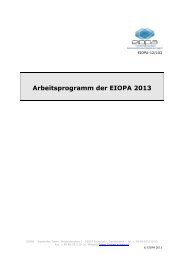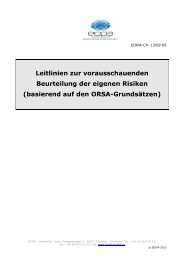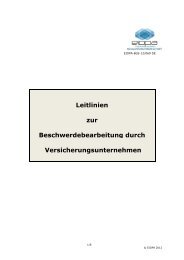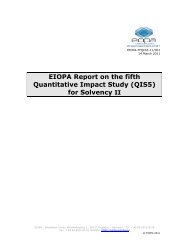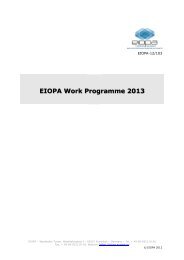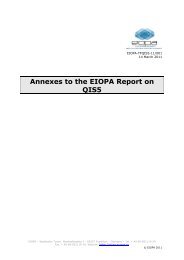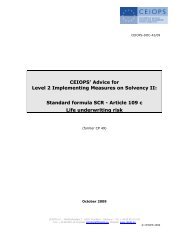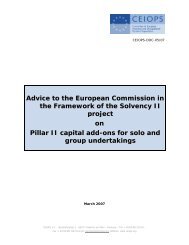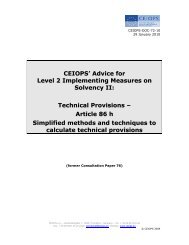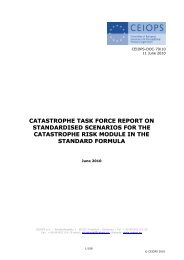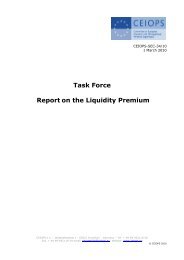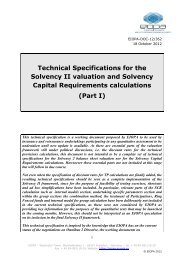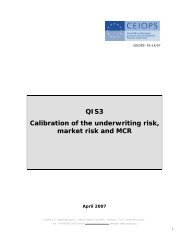Answers to the European Commission on the ... - Eiopa - Europa
Answers to the European Commission on the ... - Eiopa - Europa
Answers to the European Commission on the ... - Eiopa - Europa
You also want an ePaper? Increase the reach of your titles
YUMPU automatically turns print PDFs into web optimized ePapers that Google loves.
eas<strong>on</strong>ably simple manner. It would not naturally include <str<strong>on</strong>g>the</str<strong>on</strong>g> results of<br />
scenario analyses, although <str<strong>on</strong>g>the</str<strong>on</strong>g>se could be incorporated at <str<strong>on</strong>g>the</str<strong>on</strong>g> expense<br />
of greater complexity. However, <str<strong>on</strong>g>the</str<strong>on</strong>g> approach could be quite rigorous,<br />
and <str<strong>on</strong>g>the</str<strong>on</strong>g> effect of approximati<strong>on</strong>s and uncertainties could be analysed in<br />
some detail.<br />
10.42 The bot<str<strong>on</strong>g>to</str<strong>on</strong>g>m-up method is simpler in principle, but it may be difficult <str<strong>on</strong>g>to</str<strong>on</strong>g><br />
combine different risks in anything more than an ad hoc manner. As a<br />
result, it could be more difficult <str<strong>on</strong>g>to</str<strong>on</strong>g> understand <str<strong>on</strong>g>the</str<strong>on</strong>g> weaknesses of <str<strong>on</strong>g>the</str<strong>on</strong>g><br />
resulting formula. Important sources of risks may not be reflected in<br />
<str<strong>on</strong>g>the</str<strong>on</strong>g> c<strong>on</strong>stituent parts of <str<strong>on</strong>g>the</str<strong>on</strong>g> standard formula, skewing <str<strong>on</strong>g>the</str<strong>on</strong>g> overall<br />
result. In additi<strong>on</strong>, it is not always possible (or sensible) <str<strong>on</strong>g>to</str<strong>on</strong>g> c<strong>on</strong>sider<br />
risks in isolati<strong>on</strong>.<br />
10.43 In practice, <str<strong>on</strong>g>the</str<strong>on</strong>g> two methodologies should be seen as complementary<br />
ra<str<strong>on</strong>g>the</str<strong>on</strong>g>r than c<strong>on</strong>tradic<str<strong>on</strong>g>to</str<strong>on</strong>g>ry, and both should be used in <str<strong>on</strong>g>the</str<strong>on</strong>g> development<br />
of <str<strong>on</strong>g>the</str<strong>on</strong>g> standard formula.<br />
Modelling approaches <str<strong>on</strong>g>to</str<strong>on</strong>g> <str<strong>on</strong>g>the</str<strong>on</strong>g> main risk categories<br />
Risk dependencies<br />
10.44 Generally, CEIOPS may assume that not all risks will occur at <str<strong>on</strong>g>the</str<strong>on</strong>g> same<br />
time. Due <str<strong>on</strong>g>to</str<strong>on</strong>g> diversificati<strong>on</strong> effects, <str<strong>on</strong>g>the</str<strong>on</strong>g> overall capital requirement<br />
might be smaller than <str<strong>on</strong>g>the</str<strong>on</strong>g> sum of <str<strong>on</strong>g>the</str<strong>on</strong>g> capital comp<strong>on</strong>ents for <str<strong>on</strong>g>the</str<strong>on</strong>g><br />
individual risks. Simple additi<strong>on</strong> of <str<strong>on</strong>g>the</str<strong>on</strong>g> comp<strong>on</strong>ents could <str<strong>on</strong>g>the</str<strong>on</strong>g>refore<br />
overstate <str<strong>on</strong>g>the</str<strong>on</strong>g> appropriate amount of capital.<br />
10.45 A comm<strong>on</strong>ly used ma<str<strong>on</strong>g>the</str<strong>on</strong>g>matical <str<strong>on</strong>g>to</str<strong>on</strong>g>ol <str<strong>on</strong>g>to</str<strong>on</strong>g> analyse risk dependencies is<br />
linear correlati<strong>on</strong>. Linear correlati<strong>on</strong> is based <strong>on</strong> <str<strong>on</strong>g>the</str<strong>on</strong>g> assumpti<strong>on</strong> of<br />
linear dependency between risks and has <str<strong>on</strong>g>the</str<strong>on</strong>g> advantage of familiarity,<br />
as well as being relatively easy <str<strong>on</strong>g>to</str<strong>on</strong>g> compute. However, its effectiveness<br />
is limited, particularly as insurance risks are not generally subject <str<strong>on</strong>g>to</str<strong>on</strong>g> a<br />
normal distributi<strong>on</strong>. For risks that follow a heavily-skewed distributi<strong>on</strong>,<br />
or for risks where <str<strong>on</strong>g>the</str<strong>on</strong>g> dependency relati<strong>on</strong>ship is n<strong>on</strong>-linear, a linear<br />
correlati<strong>on</strong> assumpti<strong>on</strong> may underestimate capital requirements 87 . In<br />
additi<strong>on</strong>, normally uncorrelated risks may become highly correlated in<br />
extreme circumstances.<br />
10.46 Notwithstanding its <str<strong>on</strong>g>the</str<strong>on</strong>g>oretical deficiencies, linear correlati<strong>on</strong>, <str<strong>on</strong>g>to</str<strong>on</strong>g>ge<str<strong>on</strong>g>the</str<strong>on</strong>g>r<br />
with a simplified form of tail correlati<strong>on</strong>, may provide a starting point<br />
(and practical expedient) for <str<strong>on</strong>g>the</str<strong>on</strong>g> standard formula. However, it would<br />
be important <str<strong>on</strong>g>to</str<strong>on</strong>g> keep note of any dependencies that would not be<br />
addressed properly by this treatment.<br />
10.47 An important associated questi<strong>on</strong> is <str<strong>on</strong>g>the</str<strong>on</strong>g> degree of granularity in <str<strong>on</strong>g>the</str<strong>on</strong>g><br />
analysis. Breaking down risks in<str<strong>on</strong>g>to</str<strong>on</strong>g> many categories and <str<strong>on</strong>g>the</str<strong>on</strong>g>n assuming<br />
independence may underestimate <str<strong>on</strong>g>the</str<strong>on</strong>g> capital needs if, in reality, some<br />
of <str<strong>on</strong>g>the</str<strong>on</strong>g> categories turn out <str<strong>on</strong>g>to</str<strong>on</strong>g> be positively correlated. C<strong>on</strong>versely, using<br />
87<br />
See Embrechts, McNeil, Straumann, Correlati<strong>on</strong> and Dependency in Risk Management: Properties and<br />
Pitfalls,<br />
90



